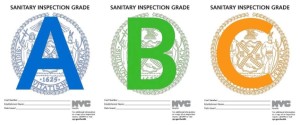I said to myself, I gotta start sleeping in, adjust to Australia, but, like Al Pacino in Godfather III, “Every time I try to get out, they pull me back in.”
So I had Good Morning America on at 3:30 a.m. Brisbane time this morning from the Monday U.S. broadcast, and what do I see, but a story about restaurant inspection disclosure and grading.
Rob Mancini, this is screaming for you.
Many cities across the country are adopting a letter-grade inspection system that requires restaurant operators to post publicly their health inspection grades for all to see.
But what about your own kitchen at home?
“GMA” Investigates decided to give some home kitchens a surprise visit with former New York City health inspector Kervyn Mark, who now works with Letter Grade Consulting, a private company. We scored violations based on New York City’s points system, in which every health code violation gets you points. The higher the points, the lower the grade.
With a score of 13 points or lower, an operator will earn an A grade. A B grade is earned with 14 to 27 points. Anything at 28 points or more earns the operator a C.
“GMA” and Mark came up with a “GMA” home kitchen inspection sheet to score violations based on New York City’s points system, and then we went knocking on doors.
We inspected Wanda Stathis-Jurgensen’s kitchen. Mark checked the temperature of food in her refrigerator, finding that stored rice was four degrees warmer than the 41 degrees it should have been. Stathis-Jurgensen didn’t have a meat thermometer, which is important to ensuring the proper minimum temperature of cooked meat. We also found dust under the hood of the stove.
“See all this dust. It can drop into the food and cause physical contamination,” Mark said.
“GMA” Investigates also checked under the sink. We did not find any mice, but we did find little bits of food.
 With a few other violations, Stathis-Jurgensen’s score was 40 points, or a grade of C.
With a few other violations, Stathis-Jurgensen’s score was 40 points, or a grade of C.
Around the corner, Christian Hobbis kitchen appeared spotless. The dishwashing sponge was clean, all vents were clean and all chemicals were stored away from food, but a closer inspection revealed an expired milk carton.
With a few others issues uncovered, Hobbis earned a B.
In Jennifer Madison’s kitchen, we found separate cutting boards – one for fish, one for vegetables and one for poultry. It’s a good way to prevent cross-contamination.
But Madison, who has three children, was shocked to discover she had violated a major rule about leaving dinner out on the stove.
“I try to have dinner ready at like, 5, but I will let it sit out on the stove until 8:30,” she said.
After so many hours out, Mark told Madison she couldn’t put that food into the refrigerator because “it would have accumulated too much bacteria.”
We also found mildew inside her dishwasher, and Madison wanted to know whether that was making her dishes dirty.
“No, but at the end of the day it can contaminate if not treated properly,” Mark replied.
Two other violations gave her 12 points – our scoring system did not penalize her for leaving food out – so she ended up scoring an A. and she ended up scoring an A.
Overall, these home kitchens made the grade, and their violations could be easily fixed in an afternoon. Wanda Stathis-Jurgensen, who got a C, said she was going to get to work on the violations in her kitchen right away.
One other violation “GMA” Investigates spotted in several of the homes was deeply dented cans, which raises a concern about botulism.
Because cans are lined in the inside, when they are dented, the chemicals from the lining can seep into your food.
You don’t have to throw the cans away; take them back to your grocery store and ask for a new can.
The video can be found here.

